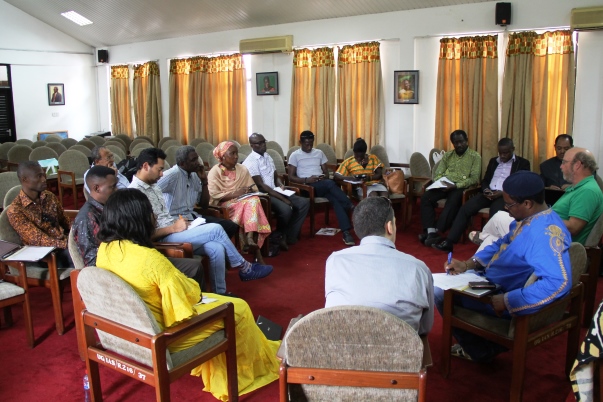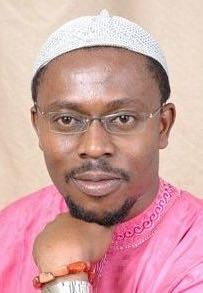Perspectives on IARJ in Africa: Prince Charles Dickson

Just how big is Africa?
Endy Bayuni, Executive Director of the International Association of Religion Journalists (IARJ) asked me just before the conference Reporting on Religion and Spirituality in Africa,
held by the IARJ in Accra, Ghana.

Bayuni’s question stuck in my mind during my stay in Accra, where, together with roughly two dozen journalists and scholars from different African countries, I was greeted by the lovely Ghanaian hospitality of Akwaaba
meaning Welcome
in Twi, one of the local languages.
The Conference brought together journalists and scholars from Algeria, Ghana, Togo, Liberia, Sudan, Nigeria, Cameroon, South Africa, Ethiopia, Brazil, US, Italy. During the two-day meeting, we discussed, debated, learned from one another and shared ideas and experiences. We especially focused on the needs and challenges religion journalists are facing in Africa. As we navigated those murky waters in this continent with great potential, we asked: Do many religions equal many problems?
The variety of religions in Africa was only one of the many topics we tackled, including the way religious information sources are dealing with media outlets and journalists; trends and latest research on issues in global religion; interreligious dialogue; religion’s use of the media and new media in spreading their message; covering extremism and conflicts.
Journalists face many challenges in covering religion and spirituality, as shown by the rewarding debate we had during the conference on the distinctive roles of state and religion. Whether it was the Ghanaian, the Ethiopian experience or what was applicable in Nigeria, South Africa and Algeria, there were nuggets of not only age-old wisdom but also differences in our experiences.
We made a yeoman’s effort at distinguishing religious reporting
and reporting on religion.
We also looked beyond the two big religions represented in the continent—Christianity and Islam—and explored indigenous faiths existing alongside the major religions, like in Togo.
The Conference could not shy away from the role of religion on terror, violent extremism and hate speech, and the role of journalists themselves, in covering conflict and extremism. The challenges associated with covering extremism and conflict were explored by Nigerian journalists Blessing Tunoh and Odinga Adiwu, who brought up an enriching discussion on the ongoing activities of Boko Haram. Navigating coverage of that global story is far more complex than outsiders may imagine.
Particular attention was paid to growing Islamophobia, a topic addressed at one point by Larbi Megari from Algeria. We discussed the appropriation of new media as it relates to the growth of Pentecostalism in Africa—as well as growing secularism within certain national ideologies.
And, that religious-secular divide is yet another story that is more complex than many outsiders may realize. In South Africa, for example, a large portion of the population may be religious, but religion seems to be divorced from political life, at this point. That’s in contrast to South Sudan, where the government identifies itself as religious and there seems to be no distinction between state and religion.
Cameroonian participant Ben Modika brought up what he called commercial religion
and discussed how that emerging force affects editorial policies. Abraham Wheon, founder of the Religious Journalists of Liberia Association, talked about the role of religion in Liberia, including the civil war there.
The conference also tried to lift up the most sensitive and under-reported religious issues in different countries. This wide range of discussions at the conference showed, once again, how urgent it is is for journalists to gain more knowledge about the ever-growing field of religion reporting. Religion is a sensitive topic; it is not a subject to jump into with a toddler’s footwear. It was encouraging to see state-owed broadcast house–the Ghana Broadcasting Corporation—maintains a full religious department.
Among the most appreciated sessions in the conference, was a joint panel with the African Association for the Study of Religions (AASR). Religion scholars and journalists shared insights in an intense conversation between the two professional disciplines.
As the first IARJ conference in Africa–the sixth IARJ meeting after conferences in Bellagio (Italy), Belo Horizonte (Brazil), London, Boston (Massachusetts), Brisbane (Australia), and Buenos Aires (Argentina)–came to an end, the answer to Bayuni’s question is: Africa is big enough to have its own vast range of religious diversity.
As they say in Ghana: Me daa si!
(a big Thank you!
to the entire IARJ team), also to the Companhia Brasileira de Metalurgia e Mineração (CBMM), who sponsored the conference, to the Institute of African Studies of the University of Accra, for hosting the event.
Like they say in Twi: Mefi Ghana, yebeehyia bio!
(I miss Ghana; we will meet again!)
Prince Charles Dickson Ph.D is a freelance journalist and founding member of the IARJ and currently works with the Nexus Fund
Care to learn more?
Please follow the IARJ on Twitter and Facebook. Also, encourage friends to follow our Twitter feed, which provides fascinating news from around the world in several languages. The IARJ Twitter feed will give you a far more diverse window into the world’s religious and cultural diversity.
If you are a journalist covering religion, consider becoming a member of the IARJ.
